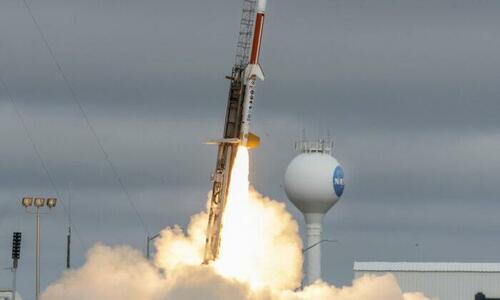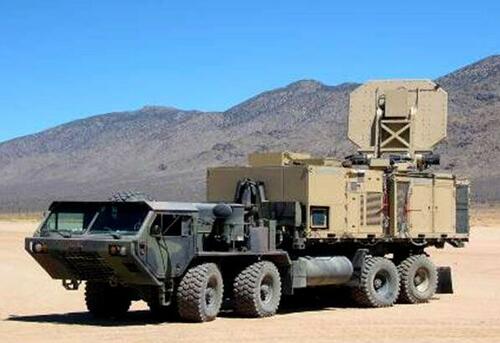
Authored by John Haughey via The Epoch Times (emphasis ours),
President Joe Biden’s $886.3 billion Fiscal Year 2024 (FY24) defense budget request includes $145 billion for research and development into emerging technologies to create new weapons systems using Artificial Intelligence (AI), hypersonic munitions, and electromagnetic swarms.

The Department of Defense (DOD) and its subsidiary military branch technology laboratories, working in tandem with universities and high-tech contractors that increasingly include small businesses, have produced such big-ticket splashes as newly deployed directed-energy weapons systems and hypersonic/ballistic sensors.
Among prospective products and systems seeking funding in the FY24 spending request is a ‘Rocket Cargo’ transport that can move 100 tons of cargo anywhere on Earth within an hour; a counter-swarm electromagnetic weapon that can disable drones and be powered from a wall plug; a rotating detonation engine without moving parts; a “pop-up hide” that can make Marines disappear in plain sight; a Predictive Vehicle Activity for Identification and Location (PreVAIL) program that “will bring a novel approach to automated target detection and recognition.”
There are also less sexy utilitarian products being tested in the budget, such as a Portable Fluid Analyzer, a ship-to-ship system that converts Morse code into text messages, and an assembly line of bigger, faster, better-armed unmanned aircraft, from micro-drones to the latest Unmanned Long-endurance Tactical Reconnaissance Aircraft (ULTRA.)
All have survived, or must soon traverse, “The Valley of Death.”
Unlike notable valleys in American military history—Valley Forge, the Chosin, Khe Sanh, the Korengal—this “Valley of Death” is not a place on a map but that dreaded moment of realization on a military product development timeline when a cutting-edge weapon that will deliver a decisive battlefield advantage cannot advance out of prototype to production and get onto the battlefield in time.

‘The Valley of Death’
Integrating new, still-maturing technologies into existing programs and platforms without “radical disruption” to multi-year procurement and acquisitions systems is among the most tweaky of challenges confronting the military, Pentagon officials said during a two-hour April 13 webinar presented by the National Defense Industrial Association (NDIA).
The DOD’s Under Secretary of Defense for Research & Engineering Heidi Shyu and the DOD’s Defense Advanced Research Projects Agency (DARPA) Director, Dr. Stefanie Tompkins, noted the proposed $145 billion Research, Development, Test, and Evaluation (RDT&E) budget is up 12 percent from this year with the Air Force receiving one-third of the requested outlay.
Shyu said the Science and Technology component of the RDT&E budget request is $17.8 billion, up 8.3 percent over this year’s $16.5 billion budget.
The annually updated National Defense Science & Technology Strategy is on Secretary of Defense Lloyd Austin’s desk, she said.
Shyu said the strategy will focus on joint mission; creation and deployment of capabilities at speed and scale; establishment of an enduring advantage in talent, infrastructure, research, and collaboration; directed energy weapons; and hypersonic/ballistic sensors.
Technology leaders for three military branches—Army Deputy Assistant Secretary for Research & Technology William Nelson, Naval Research Chief Rear Adm. Lorin Selby, Air Force Research Laboratory Commander Maj. Gen. Heather Pringle—outlined cooperative ventures with industry and workforce development plans, especially in currying bids and participation in projects by small businesses.
The $886.3 billion FY24 defense request includes $842 billion for the Pentagon with emphasis on the “growing multi-domain threat posed by the People’s Republic of China (PRC),” which the DOD has again named the nation’s most pressing “pacing challenge.”
March and April is typically when DOD and military command officers testify before congressional panels about their spending requests during the annual budget cycle leading up to Oct. 1, the official start of the federal fiscal year.
All five of the panelists at the NDIA webinar have been making the rounds on Capitol Hill to meet with congressional bean-counters to discuss funding for new whiz-bang weapons, such as fusion-based target recognition systems, to such relatively mundane innovations as snow tires for Humbles, since February.
But on April 13 before the NDIA, a Washington-based nonprofit that represents 1,800 corporations and nearly 60,000 individuals working in the defense manufacturing industry, it was all about “The Valley of Death.”

‘Moats of Despair’
Delivering new technologies developed in the commercial sector under DOD contract into the field in a seamless transition, especially when so many weapons systems are interrelated, is a daunting challenge, the officials said.
In fact, in June 2022, Deputy Secretary of Defense Kathleen Hicks called transition discord “one of our biggest problems—the so-called ‘Valley of Death,’ scaling up to full-scale production and fielding” new weapons systems.
Selby said there isn’t just one “Valley of Death” but at least three, which he described as “moats of despair.”
“The first ‘Valley of Death’” is the stage where “the first identified prototype” is manufactured and tested and “it didn’t pan out or we failed internally” to properly build and test it, he said.
“That ‘Valley of Death’ is within my control” at that point, Selby said.
The next “Valley of Death” is moving a product from prototype to production, he said, which is when other factors come into play, such as costs and manufacturing capabilities, which can make further development unfeasible. “This is a deep valley,” where many projects go to die, he said.
The final ‘Valley of Death” is “getting that production to scale,” Selby said. “You got something, something that is ready to go onto a platform, as part of a modernization package” but you don’t control production schedules especially for an item that was previously manufactured at a “low rate production.”
“The warfighter is screaming, ‘I need that and need that tomorrow’—that is [a problem] we have to solve. We have not solved it,” he said. “How do I rapidly go to scale? That’s the question. That’s how you win.”
Read more here...
Authored by John Haughey via The Epoch Times (emphasis ours),
President Joe Biden’s $886.3 billion Fiscal Year 2024 (FY24) defense budget request includes $145 billion for research and development into emerging technologies to create new weapons systems using Artificial Intelligence (AI), hypersonic munitions, and electromagnetic swarms.

The Department of Defense (DOD) and its subsidiary military branch technology laboratories, working in tandem with universities and high-tech contractors that increasingly include small businesses, have produced such big-ticket splashes as newly deployed directed-energy weapons systems and hypersonic/ballistic sensors.
Among prospective products and systems seeking funding in the FY24 spending request is a ‘Rocket Cargo’ transport that can move 100 tons of cargo anywhere on Earth within an hour; a counter-swarm electromagnetic weapon that can disable drones and be powered from a wall plug; a rotating detonation engine without moving parts; a “pop-up hide” that can make Marines disappear in plain sight; a Predictive Vehicle Activity for Identification and Location (PreVAIL) program that “will bring a novel approach to automated target detection and recognition.”
There are also less sexy utilitarian products being tested in the budget, such as a Portable Fluid Analyzer, a ship-to-ship system that converts Morse code into text messages, and an assembly line of bigger, faster, better-armed unmanned aircraft, from micro-drones to the latest Unmanned Long-endurance Tactical Reconnaissance Aircraft (ULTRA.)
All have survived, or must soon traverse, “The Valley of Death.”
Unlike notable valleys in American military history—Valley Forge, the Chosin, Khe Sanh, the Korengal—this “Valley of Death” is not a place on a map but that dreaded moment of realization on a military product development timeline when a cutting-edge weapon that will deliver a decisive battlefield advantage cannot advance out of prototype to production and get onto the battlefield in time.

‘The Valley of Death’
Integrating new, still-maturing technologies into existing programs and platforms without “radical disruption” to multi-year procurement and acquisitions systems is among the most tweaky of challenges confronting the military, Pentagon officials said during a two-hour April 13 webinar presented by the National Defense Industrial Association (NDIA).
The DOD’s Under Secretary of Defense for Research & Engineering Heidi Shyu and the DOD’s Defense Advanced Research Projects Agency (DARPA) Director, Dr. Stefanie Tompkins, noted the proposed $145 billion Research, Development, Test, and Evaluation (RDT&E) budget is up 12 percent from this year with the Air Force receiving one-third of the requested outlay.
Shyu said the Science and Technology component of the RDT&E budget request is $17.8 billion, up 8.3 percent over this year’s $16.5 billion budget.
The annually updated National Defense Science & Technology Strategy is on Secretary of Defense Lloyd Austin’s desk, she said.
Shyu said the strategy will focus on joint mission; creation and deployment of capabilities at speed and scale; establishment of an enduring advantage in talent, infrastructure, research, and collaboration; directed energy weapons; and hypersonic/ballistic sensors.
Technology leaders for three military branches—Army Deputy Assistant Secretary for Research & Technology William Nelson, Naval Research Chief Rear Adm. Lorin Selby, Air Force Research Laboratory Commander Maj. Gen. Heather Pringle—outlined cooperative ventures with industry and workforce development plans, especially in currying bids and participation in projects by small businesses.
The $886.3 billion FY24 defense request includes $842 billion for the Pentagon with emphasis on the “growing multi-domain threat posed by the People’s Republic of China (PRC),” which the DOD has again named the nation’s most pressing “pacing challenge.”
March and April is typically when DOD and military command officers testify before congressional panels about their spending requests during the annual budget cycle leading up to Oct. 1, the official start of the federal fiscal year.
All five of the panelists at the NDIA webinar have been making the rounds on Capitol Hill to meet with congressional bean-counters to discuss funding for new whiz-bang weapons, such as fusion-based target recognition systems, to such relatively mundane innovations as snow tires for Humbles, since February.
But on April 13 before the NDIA, a Washington-based nonprofit that represents 1,800 corporations and nearly 60,000 individuals working in the defense manufacturing industry, it was all about “The Valley of Death.”

‘Moats of Despair’
Delivering new technologies developed in the commercial sector under DOD contract into the field in a seamless transition, especially when so many weapons systems are interrelated, is a daunting challenge, the officials said.
In fact, in June 2022, Deputy Secretary of Defense Kathleen Hicks called transition discord “one of our biggest problems—the so-called ‘Valley of Death,’ scaling up to full-scale production and fielding” new weapons systems.
Selby said there isn’t just one “Valley of Death” but at least three, which he described as “moats of despair.”
“The first ‘Valley of Death’” is the stage where “the first identified prototype” is manufactured and tested and “it didn’t pan out or we failed internally” to properly build and test it, he said.
“That ‘Valley of Death’ is within my control” at that point, Selby said.
The next “Valley of Death” is moving a product from prototype to production, he said, which is when other factors come into play, such as costs and manufacturing capabilities, which can make further development unfeasible. “This is a deep valley,” where many projects go to die, he said.
The final ‘Valley of Death” is “getting that production to scale,” Selby said. “You got something, something that is ready to go onto a platform, as part of a modernization package” but you don’t control production schedules especially for an item that was previously manufactured at a “low rate production.”
“The warfighter is screaming, ‘I need that and need that tomorrow’—that is [a problem] we have to solve. We have not solved it,” he said. “How do I rapidly go to scale? That’s the question. That’s how you win.”
Read more here…
Loading…




